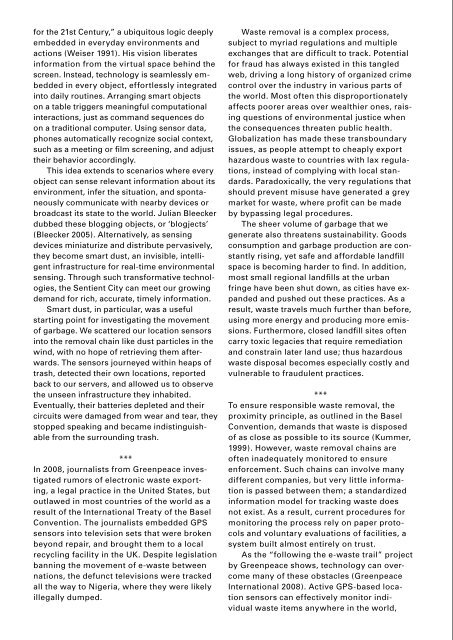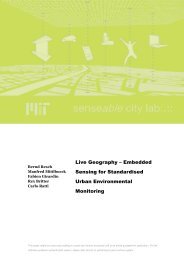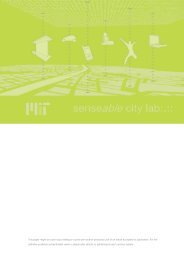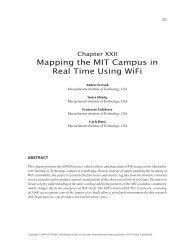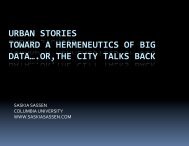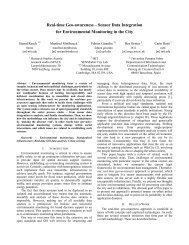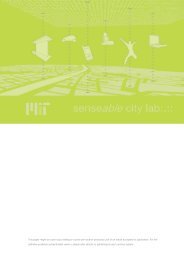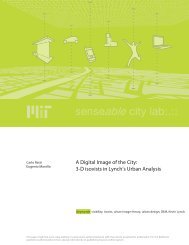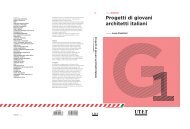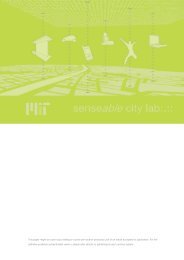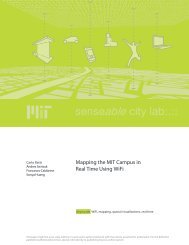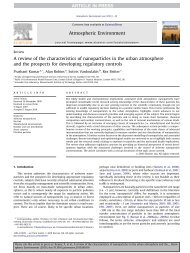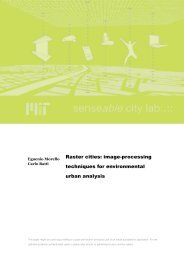Urban Digestive Systems. Towards the Sentient City. - MIT ...
Urban Digestive Systems. Towards the Sentient City. - MIT ...
Urban Digestive Systems. Towards the Sentient City. - MIT ...
- No tags were found...
You also want an ePaper? Increase the reach of your titles
YUMPU automatically turns print PDFs into web optimized ePapers that Google loves.
for <strong>the</strong> 21st Century,” a ubiquitous logic deeplyembedded in everyday environments andactions (Weiser 1991). His vision liberatesinformation from <strong>the</strong> virtual space behind <strong>the</strong>screen. Instead, technology is seamlessly embeddedin every object, effortlessly integratedinto daily routines. Arranging smart objectson a table triggers meaningful computationalinteractions, just as command sequences doon a traditional computer. Using sensor data,phones automatically recognize social context,such as a meeting or film screening, and adjust<strong>the</strong>ir behavior accordingly.This idea extends to scenarios where everyobject can sense relevant information about itsenvironment, infer <strong>the</strong> situation, and spontaneouslycommunicate with nearby devices orbroadcast its state to <strong>the</strong> world. Julian Bleeckerdubbed <strong>the</strong>se blogging objects, or ‘blogjects’(Bleecker 2005). Alternatively, as sensingdevices miniaturize and distribute pervasively,<strong>the</strong>y become smart dust, an invisible, intelligentinfrastructure for real-time environmentalsensing. Through such transformative technologies,<strong>the</strong> <strong>Sentient</strong> <strong>City</strong> can meet our growingdemand for rich, accurate, timely information.Smart dust, in particular, was a usefulstarting point for investigating <strong>the</strong> movementof garbage. We scattered our location sensorsinto <strong>the</strong> removal chain like dust particles in <strong>the</strong>wind, with no hope of retrieving <strong>the</strong>m afterwards.The sensors journeyed within heaps oftrash, detected <strong>the</strong>ir own locations, reportedback to our servers, and allowed us to observe<strong>the</strong> unseen infrastructure <strong>the</strong>y inhabited.Eventually, <strong>the</strong>ir batteries depleted and <strong>the</strong>ircircuits were damaged from wear and tear, <strong>the</strong>ystopped speaking and became indistinguishablefrom <strong>the</strong> surrounding trash.***In 2008, journalists from Greenpeace investigatedrumors of electronic waste exporting,a legal practice in <strong>the</strong> United States, butoutlawed in most countries of <strong>the</strong> world as aresult of <strong>the</strong> International Treaty of <strong>the</strong> BaselConvention. The journalists embedded GPSsensors into television sets that were brokenbeyond repair, and brought <strong>the</strong>m to a localrecycling facility in <strong>the</strong> UK. Despite legislationbanning <strong>the</strong> movement of e-waste betweennations, <strong>the</strong> defunct televisions were trackedall <strong>the</strong> way to Nigeria, where <strong>the</strong>y were likelyillegally dumped.Waste removal is a complex process,subject to myriad regulations and multipleexchanges that are difficult to track. Potentialfor fraud has always existed in this tangledweb, driving a long history of organized crimecontrol over <strong>the</strong> industry in various parts of<strong>the</strong> world. Most often this disproportionatelyaffects poorer areas over wealthier ones, raisingquestions of environmental justice when<strong>the</strong> consequences threaten public health.Globalization has made <strong>the</strong>se transboundaryissues, as people attempt to cheaply exporthazardous waste to countries with lax regulations,instead of complying with local standards.Paradoxically, <strong>the</strong> very regulations thatshould prevent misuse have generated a greymarket for waste, where profit can be madeby bypassing legal procedures.The sheer volume of garbage that wegenerate also threatens sustainability. Goodsconsumption and garbage production are constantlyrising, yet safe and affordable landfillspace is becoming harder to find. In addition,most small regional landfills at <strong>the</strong> urbanfringe have been shut down, as cities have expandedand pushed out <strong>the</strong>se practices. As aresult, waste travels much fur<strong>the</strong>r than before,using more energy and producing more emissions.Fur<strong>the</strong>rmore, closed landfill sites oftencarry toxic legacies that require remediationand constrain later land use; thus hazardouswaste disposal becomes especially costly andvulnerable to fraudulent practices.***To ensure responsible waste removal, <strong>the</strong>proximity principle, as outlined in <strong>the</strong> BaselConvention, demands that waste is disposedof as close as possible to its source (Kummer,1999). However, waste removal chains areoften inadequately monitored to ensureenforcement. Such chains can involve manydifferent companies, but very little informationis passed between <strong>the</strong>m; a standardizedinformation model for tracking waste doesnot exist. As a result, current procedures formonitoring <strong>the</strong> process rely on paper protocolsand voluntary evaluations of facilities, asystem built almost entirely on trust.As <strong>the</strong> “following <strong>the</strong> e-waste trail” projectby Greenpeace shows, technology can overcomemany of <strong>the</strong>se obstacles (GreenpeaceInternational 2008). Active GPS-based locationsensors can effectively monitor individualwaste items anywhere in <strong>the</strong> world,highlighting potential abuse. Because sensorsare irretrievable once thrown away, GSM(Global Standard for Mobile Communications)and o<strong>the</strong>r mobile phone networks are importantinfrastructures for real-time communication.Online databases collect and storethis data remotely; advanced analytical andmapping software allow us to make sense ofmassive amounts of location data and pickout patterns from <strong>the</strong> noise.There are also low-tech methods of tracking<strong>the</strong> motion of refuse, like relying on manyvolunteers to act as temporary sensors. A famousnaval spill of 29,000 rubber toys in 1992enabled a long-term study of ocean currentsin <strong>the</strong> Pacific. Oceanographers Ebbesmeyerand Ingraham recruited local residents,visitors, and beach workers to recover toysbeing washed ashore in Alaska. Based on <strong>the</strong>locations of around 400 found toys, scientistsrefined <strong>the</strong>ir models of oceanic currents andcorrectly predicted <strong>the</strong> trajectories of <strong>the</strong>remaining toys (Ebbesmeyer et al. 2007). Thisdemonstrates what can be achieved by engaginga community even without expensivetracking technology.Beyond <strong>the</strong> tracking process itself, <strong>the</strong>re areimportant precedents for communicating ourobservations to <strong>the</strong> public. One relevant priorwork is Eric Paulos’ Jetsam project (Paulos andJenkins 2005), which sought to improve publicawareness of waste issues. They deployed atrash bin in public space that was equippedwith various sensors and network connectivity.This ‘augmented trash bin’ gave feedback toits users by displaying statistical informationabout collected waste via projected visualizations.Such real-time feedback can deliverinformation about waste disposal in an intelligible,resonant way, and could potentially drivegreater awareness and behavioral change.These examples are at <strong>the</strong> core of whatwe are after. Yet, Trash Track goes beyondall of <strong>the</strong> above approaches, using pervasivetechnologies and volunteer mobilization toexpose challenges of waste management andsustainability to <strong>the</strong> world. It builds on previouswork by <strong>the</strong> SENSEable <strong>City</strong> Lab thatexplores how <strong>the</strong> increasing deployment ofsensors and mobile technologies radicallytransforms our understanding and descriptionof cities. The project is an initial investigationinto understanding <strong>the</strong> removal chain in urbanareas, and represents a model for change thatis taking hold in cities: a bottom-up approachto managing resources and promoting environmentalawareness. Trash Track hints at animportant, but little discussed aspect of <strong>the</strong>vision described as <strong>the</strong> Internet of Things. Asargued by <strong>the</strong> novelist Bruce Sterling, we candirect every object to <strong>the</strong> optimal reuse scenarioand ultimately achieve a condition withzero waste, if we know where all things are in<strong>the</strong> world (Sterling 2005).Technology DesignThe whole project has made me much moreoptimistic about our ability to find solutions tobig, complex problems. Seeing how <strong>the</strong> peopleinvolved in <strong>the</strong> project are using <strong>the</strong>ir creativityand scientific expertise to tackle something asmundane yet complicated as trash disposal isvery encouraging.— Trash Track volunteer survey***The Trash Track project was conceived in <strong>the</strong>summer of 2008 as a proposal for <strong>the</strong> Toward<strong>the</strong> <strong>Sentient</strong> <strong>City</strong> exhibition, organized by <strong>the</strong>Architectural League of New York. Rex Britter, avisiting scientist with <strong>the</strong> SENSEable <strong>City</strong> Lab,suggested <strong>the</strong> idea of tracking garbage in <strong>the</strong>city in order to better understand <strong>the</strong> collectionof waste — which Bill Mitchell dubbed <strong>the</strong> ‘removalchain’ as <strong>the</strong> counterpart to <strong>the</strong> supplychain — and eventually improve its logistics.Tracking trash intrigued us both as a windowinto its environmental impact on <strong>the</strong> city and asan extension to <strong>the</strong> Lab’s past work in diffusepervasive digital sensing to explore <strong>the</strong> physicalcontext of <strong>the</strong> city.The Trash Track concept also raised questionsand concerns in its developmental phase.Was <strong>the</strong> inevitable deposit of potentially toxictracking electronics into landfills contrary to <strong>the</strong>environmental goal of <strong>the</strong> project? Any demonstrationof this technology would inevitablyproduce a small amount of electronic waste,but <strong>the</strong> knowledge and information obtained bytracking waste products could provide enormousbenefits outweighing <strong>the</strong> risks. Thinkingahead to <strong>the</strong> future, it will be possible to carryout projects like Trash Track in more environmentallyfriendly ways. Rapid miniaturization,organically based batteries, and self-poweringmethods will all contribute to <strong>the</strong> greening ofelectronic sensing devices.94-95 <strong>MIT</strong> Senseable <strong>City</strong> Lab Trash Track


